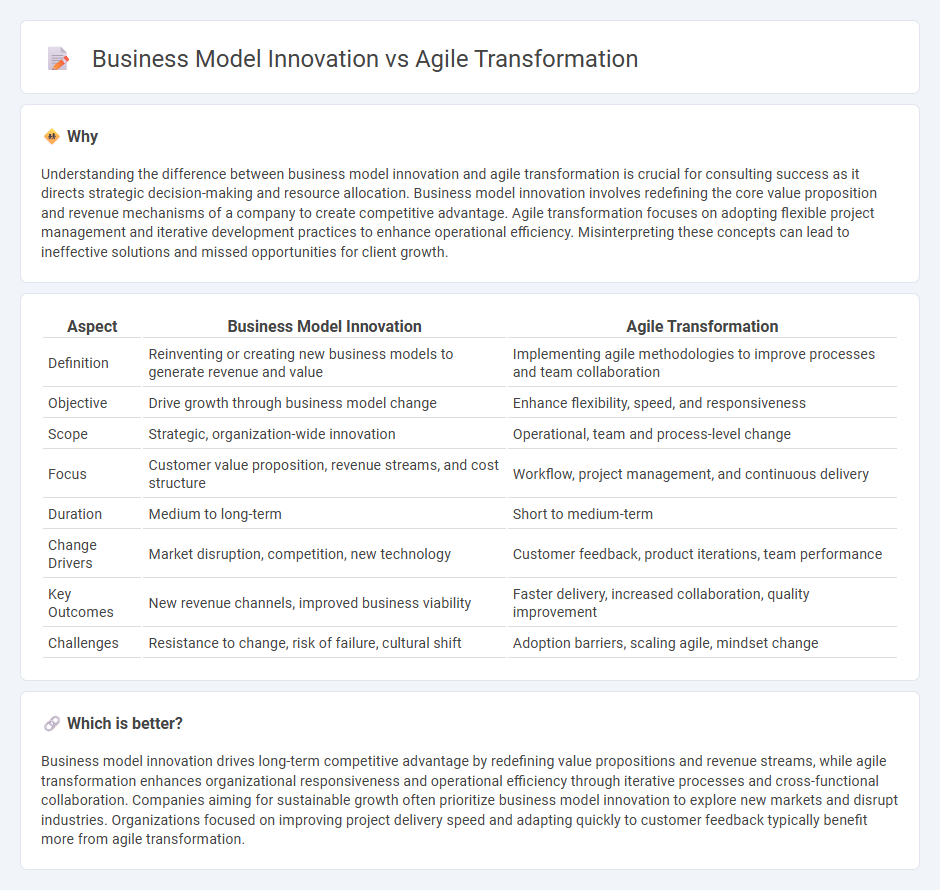
Business model innovation focuses on redefining value propositions and revenue streams to capture new market opportunities, while agile transformation emphasizes adaptive project management and continuous delivery to improve operational efficiency. Both approaches drive organizational growth but target different aspects of business evolution--strategic reinvention versus process agility. Explore how aligning these methodologies can accelerate sustainable competitive advantage.
Why it is important
Understanding the difference between business model innovation and agile transformation is crucial for consulting success as it directs strategic decision-making and resource allocation. Business model innovation involves redefining the core value proposition and revenue mechanisms of a company to create competitive advantage. Agile transformation focuses on adopting flexible project management and iterative development practices to enhance operational efficiency. Misinterpreting these concepts can lead to ineffective solutions and missed opportunities for client growth.
Comparison Table
| Aspect | Business Model Innovation | Agile Transformation |
|---|---|---|
| Definition | Reinventing or creating new business models to generate revenue and value | Implementing agile methodologies to improve processes and team collaboration |
| Objective | Drive growth through business model change | Enhance flexibility, speed, and responsiveness |
| Scope | Strategic, organization-wide innovation | Operational, team and process-level change |
| Focus | Customer value proposition, revenue streams, and cost structure | Workflow, project management, and continuous delivery |
| Duration | Medium to long-term | Short to medium-term |
| Change Drivers | Market disruption, competition, new technology | Customer feedback, product iterations, team performance |
| Key Outcomes | New revenue channels, improved business viability | Faster delivery, increased collaboration, quality improvement |
| Challenges | Resistance to change, risk of failure, cultural shift | Adoption barriers, scaling agile, mindset change |
Which is better?
Business model innovation drives long-term competitive advantage by redefining value propositions and revenue streams, while agile transformation enhances organizational responsiveness and operational efficiency through iterative processes and cross-functional collaboration. Companies aiming for sustainable growth often prioritize business model innovation to explore new markets and disrupt industries. Organizations focused on improving project delivery speed and adapting quickly to customer feedback typically benefit more from agile transformation.
Connection
Business model innovation drives companies to rethink value creation, requiring agile transformation to implement changes rapidly and respond to market feedback effectively. Agile methodologies facilitate iterative development, enabling continuous improvement and flexibility crucial for testing new business models. This synergy accelerates organizational adaptability, ensuring sustained competitive advantage in dynamic markets.
Key Terms
Agile Transformation:
Agile transformation involves restructuring an organization's processes, culture, and teams to embrace iterative development, rapid feedback, and continuous improvement, enhancing responsiveness to market changes. This approach emphasizes cross-functional collaboration, lean workflows, and adaptive planning to accelerate product delivery and innovation cycles. Discover how Agile transformation can revolutionize your business agility and competitiveness.
Scrum Framework
Agile transformation centers on adopting the Scrum Framework to enhance team collaboration, increase delivery speed, and improve product quality within existing business structures. Business model innovation involves rethinking value creation, customer segments, and revenue streams to drive sustained competitive advantage, often beyond the scope of Scrum practices. Explore how aligning Agile transformation with business model innovation can unlock new growth opportunities and operational excellence.
Change Management
Agile transformation centers on iterative processes to enhance organizational responsiveness, while business model innovation fundamentally reshapes value creation and delivery mechanisms. Both initiatives demand robust change management strategies to address cultural shifts, stakeholder engagement, and continuous learning. Explore effective methods to integrate change management and drive successful transformations.
Source and External Links
Agile Transformation: The Guide to Getting Started - Agile transformation requires executive support, defining a vision, and building a detailed roadmap with incremental delivery, emphasizing team formation and iterative progress management.
What is Agile Transformation? | Definition and Overview - ProductPlan - Agile transformation is a comprehensive organizational change process involving leadership designation, goal setting, communication plans, cross-functional teams, culture shifts, ongoing coaching, and new workflows to create a nimble, reactive enterprise.
What is Agile Transformation? Types, Benefits, and Six ... - Aha.io - Successful agile transformation requires embracing change, evolving team skills, iterative workflows, investing in tools, collaborating closely across functions, and tracking relevant agile metrics over time.
 dowidth.com
dowidth.com